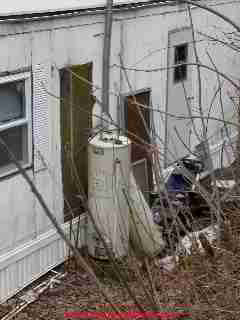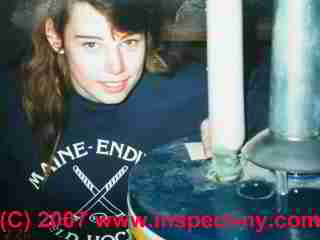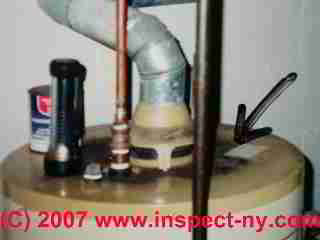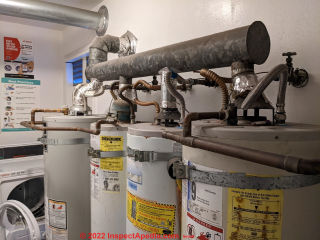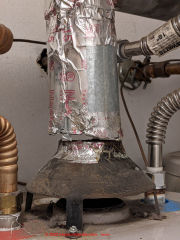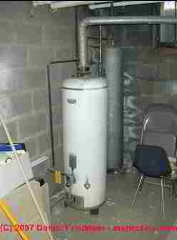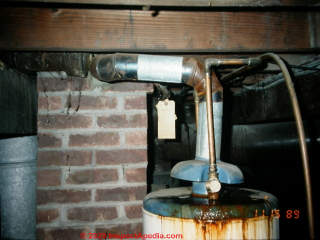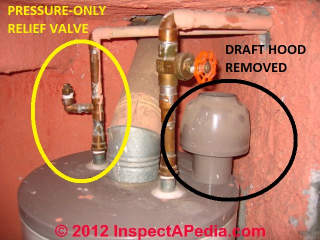 Gas-fired Hot Water Heater Venting Safety
Gas-fired Hot Water Heater Venting Safety
Unsafe venting of calorifiers, geysers, cylinders, water heaters
- POST a QUESTION or COMMENT about gas fired hot water heaters: types, installation, troubleshooting, repairs
Gas water heater venting safety inspection & defects list.
Here we describe common venting safety hazards at gas fired geysers or domestic water heaters such as venting the heater by itself into an old masonry chimney or blocked vents or flues.
Watch out: improper venting of a gas fired water heater (or cylinder or calorifier) risks production of fatal carbon monoxide in the building where the heater is located.
The articles at this website will answer most questions about all types of hot water heaters as well as many other building plumbing system inspection or defect topics.
LP & Natural Gas-fueled calorifiers, hot water cylinders, water heaters. This page contains links to in-depth articles on inspecting, testing, and repairing problems residential hot water heaters of all types, including their parts, controls, and alternative sources for hot water as well as tips for improving hot water temperature, hot water pressure, and hot water quantity.
InspectAPedia tolerates no conflicts of interest. We have no relationship with advertisers, products, or services discussed at this website.
- Daniel Friedman, Publisher/Editor/Author - See WHO ARE WE?
Gas Fired Water Heater Chimney & Venting Defects
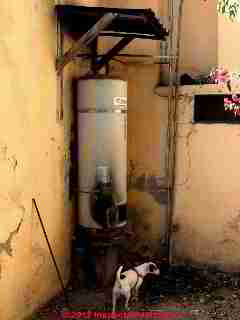 Our photo shows an LP gas fired water heater that caught fire. This outdoor water heater installation was observed at the Ex Hacienda, Gogorron, San Luis Potosi, Mexico.
Our photo shows an LP gas fired water heater that caught fire. This outdoor water heater installation was observed at the Ex Hacienda, Gogorron, San Luis Potosi, Mexico.
The complete absence of a venting chimney on this heater may have been a factor in its poor operation. The water heater inspection dog was a volunteer.
Check for proper exhaust venting of combustion products from your gas fired water heater. If necessary see these gas water heater venting guides given in the RECOMMENDED ARTICLES at the end of this page.
Venting a gas fueled water heater into an old masonry chimney or too-large flue warnings:
Watch out: Where a gas fired water heater is connected to a large masonry chimney it may not be able to develop sufficient draft to vent properly. The result could be dangerous spillage of flue gases into the building.
Explanation:
When both a building-heater (boiler or furnace) and a domestic hot water heater are venting into a chimney there is enough heat to establish an updraft.
Even though both types of gas fired equipment are cycling on and off periodically the operation of the larger building heater helps keep the masonry chimney flue sufficiently warm as to produce updraft for both the building heater and the water heater.
But when a water heater alone, a much smaller gas fired appliance, vents into the same large cold chimney flue, it cannot generate enough heat to cause the large volume of cold air in the chimney to rise and thus successfully vent outdoors at the rooftop.
Instead a bolus of hot gases form at the base of the chimney (not always but enough that it's considered a serious danger). That in turn causes backpressure so that the heater vents not up the chimney but instead out at its draft hood or on occasion even out at the burner.
Anything that reduces the proper draft at a gas appliance also changes the air - fuel mix. That in turn can be the cause of significant carbon dioxide.
So we have in your case a double hazard
1. the large old cold chimney is at risk of not venting the water heater, causing backdrafting and spillage of flue gases into the building instead of venting them outside
2. the reduced draft at the gas fired heater can result in improper combustion and a significant elevation in the production of fatal carbon monoxide gas.
Shared flue warnings:
Where a gas fired water heater shares a chimney with other heaters such as a boiler, venting of the water heater's combustion products may be unreliable, depending on whether the other larger appliance is operating or not.
Some jurisdictions do not permit sharing a flue between a gas fired appliance and other fuels such as oil; other communities may permit shared flues provided the gas vent is properly connected: usually entering the main chimney flue below rather than above the more powerfully-venting oil fired appliance.
Watch out: a blocked or leaky gas appliance venting flue is likely to cause dangerous, possibly fatal carbon monoxide leaks into a building.
Short or missing gas fired water heater flue & chimney warnings
A gas fired water heater whose exhaust flue is too short may fail to develop adequate draft to vent the water heater safely and properly.
See your water heater's installation manual for the minimum allowable water heater chimney or flue height, and consider also the effects on water heater chimney draft of installations in cold or hot climates.
Outdoor Installations of Gas Fired Water Heaters
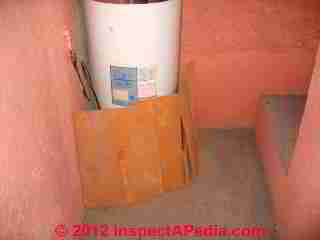 In our photo at left you can see an LP gas fired water heater installed outdoors beside a mobile home that we inspected in Monticello, N.Y.
In our photo at left you can see an LP gas fired water heater installed outdoors beside a mobile home that we inspected in Monticello, N.Y.
Notice (click to enlarge any InspectApedia image) that the water heater is not connected to its chimney, is installed outdoors with no protection from the weather, and is installed in a climate subject to freezing weather.
Also notice the old dead water heater leaning against its replacement. We figured that this water heater, if it's working at all, will soon join its sister. This is an improper and unsafe water heater installation.
Even a semi-outdoor installation such as the LP gas fired water heater shown at left can have problems. This water heater (inspected in San Miguel de Allende, Guanajuato, Mexico) is installed where it is completely protected from rain.
But the water heater was not adequately protected from periodic strong winds.
The clue that led to this finding was the parade of clay floor tiles stacked around the water heater bottom in a (usually successful) attempt to prevent the wind from blowing out the pilot light for this water heater.
Watch out: extreme measures to protect a gas fired (pilot light type) water heater from being blown out by wind may risk blocking combustion air - resulting in dangerous, potentially fatal carbon monoxide poisoning even at an outdoor water heater if the heater is not properly vented and is installed where its exhaust gases may enter a building.
See the water heater photo just above, outside the mobile home window, for an example of this hazard.
Blocked or missing gas water heater draft hood warning
On occasion we find items stored atop of a gas fired water heater, or as in the photo at below left, debris which has been drawn into and around the draft hood, interfering with proper water heater draft and risking unsafe venting of combustion gases from the building.
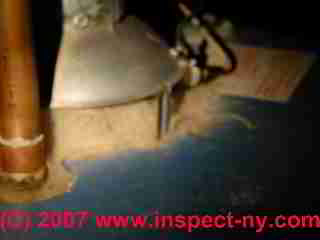
At the property where we took the photo above, the occupants had kept a number of large, hairy, shedding dogs in the basement utility area and their hair had clogged the water heater vent.
In our LP gas fired water heater photo shown below, the installer simply didn't have room for the draft hood when the water heater was installed, so he just omitted it - leaving the draft hood atop the water heater but not connected - let somebody else figure out this installation he decided.
Watch out: Without its draft hood a gas fired heating appliance cannot be expected to operate properly & safely. We discuss gas appliance draft hoods further
at DRAFT REGULATORS / HOODS GAS HEATERS.
Check for Gas Water Heater Flue Gas Spillage
Check for evidence of flue gas spillage at the gas fired water heater's draft hood by looking for burn marks, rust, soot or debris.
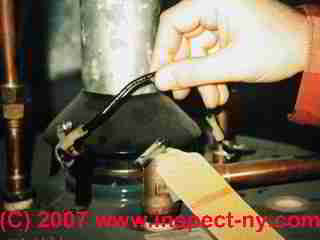 The melting pipe insulation in our photo at left indicates that flue gas has been spilling from this water heater.
The melting pipe insulation in our photo at left indicates that flue gas has been spilling from this water heater.
The burn marks in our right hand photo show a serious flue gas venting problem with the gas fired water heater.
If flue gas spillage detection sensors (spill switches) are required in your jurisdiction they must be properly installed, usually at the gas vent draft hood.
(On some gas fired appliances such as furnaces or boilers additional sensors may be installed at or close to the gas burner as well.)
Our photo at left shows that we found a flue gas spill switch lying atop of the gas fired water heater - it had never been installed.
Watch out: Dangerous carbon monoxide warning & soot from gas appliances:
If any gas fired appliance is producing soot it should be shut down immediately, inspected, and repaired before use.
Soot from a gas appliance, or high levels of indoor moisture condensation that are traced to that appliance, are indicators of improper venting of combustion products and risk the production of dangerous, potentially fatal carbon monoxide gas.
See FLUE GAS SPILL SWITCH TRIPPING & RESET for details about the flue gas spillage sensor switch.
Above: signs of flue gas spillage at the water heater draft hood: heat from water heater exhaust spillage has melted plastic-foam insulation on a nearby water pipe.
Below: - sooting and burns from back-drafting at the top of this gas fueled water heater. This heater shared a chimney with an oil fired heating boiler. When the boiler was running it back-drafted out of the water heater draft hood.
Check for Unsafe Venting or Inadequate Combustion Air: Dangerous Carbon Monoxide Hazards
Reader Comment: multiple water heaters with inadequate, un-safe vent connection to chimney
With a poster in the background sporting the phrase "Best Practices" this gang of four gas fueled water heaters is vented into a single, common, under-sized flue vent connector into a chimney of unknown size and capacity, possibly shared with other heating equipment.
In a second photo (below) we see that the water heater's draft hood is not even connected to the short vertical riser into the common flue vent connector, and burn marks on the heater's draft hood may indicate overheating there as well.
These photos, courtesy of B.N. were provided- 2022/03/24 - who observed that they speak for themselves, but who adds these OPINIONS:
- Some areas are rightly prohibiting tape from natural draft appliance vents, because it (a) does not work (b) it does not last and (c) tape obscures the connection or lack of connection of the pipe joints.
- The chimney that is venting this ganged water heater flue in the photo is not serving other appliances
- This flue IS in an earthquake zone and WILL NOT survive a quake
- Note the presence of a clothes dryer, which will divert air from the vent system and combined with other flaws induce backdraft.
Indeed aluminum foil tape, widely used on metal flue joints, adheres well for some years, but is certainly not going to provide a safe connnection when it's spanning an open gap like that shown in the photo just above.
Reader Question: soot formed at gas fired water heater vent or chimney
I have a propane water heater. It builds up a very thick layer of carbon inside on the burner area. It has done this now for 5 years in a row. I have replace 5 water heaters in 5 years.
My problem is I can not get anyone to properly fix my issue. I have had 3 different plumbers come out over the last 5 years. I have replaced the water heater every year now for 5 years in a row.
I have spent more than $9,000 on water heaters and repairs in the last 5 years. The propane company has come out every time and checked everything line pressure is good pressure regulators are checked, I also have a propane furnace which uses the same propane feed and has no issues. I suspect contamination in the propane tank but the propane company disagrees mainly because my furnace has no issues.
Is there an independent testing lab that I can have come out and draw a sample from my propane tank and test it?
Perhaps I should add that these 5 water heaters have all been different brands.
I was thinking it might be a problem with the water heater itself but seeing as all 5 have all had the same problem with carbon buildup and we are talking about 2 inches or more in a year enough to plug up the vent stack which is powered by the way and that causes the shutdown of the tank. Sometimes the gas valve sticks because of the buildup which causes the shutdown
But anyway it is all the same problem excessive carbon and lots of it. And all they do is replace the water heater with a new one. Every plumber says they have never seen a water heater look as bad as mine does. They are all stumped and so am I. Quite frankly I am at the end of my rope with this.
This Q&A were posted originally
at WATER HEATERS - home
Reply: watch out for potentially fatal carbon monoxide poisoning & watch for gas leaks
Dan I can only *speculate* as information is very incomplete in your question, but
Watch out: it sounds to me as if there is a combustion air or venting problem that risks production of dangerous, even fatal carbon monoxide gas. [There may also be a propane gas leak hazard related to this problem - Ed.]
Normal burning of propane gas produces CO2 and water vapor if combustion is complete. If combustion is incomplete because of any reason the result is CO - carbon monoxide.
You should start with an inspection of the flues, vents, chimney connections, chimney, and combustion air by a qualified expert, perhaps a chimney sweep and a qualified heating technician or by your local gas provider and building department.
Reader follow-up: ... the vacuum cleaner he was using exploded on him and filled my finished basement with a black cloud of carbon dust
Dan said:
The vent is PVC pipe it runs up 3 feet and out side of the house another 3 feet. It is 4 inch PVC and all of it was replaced last year including the vent cover on the outside of the house all done according to code and signed off by a building inspector because I demanded it last year from all involved parties.
I did not want this to happen again but it did anyway this year. It is a powered vent with a pressure switch that is supposed to shut down the water heater if it is not venting properly. That switch has never kicked out.
I can add now a horror story after the fact. The plumber came out to fix my hot water heater. The one I have installed now has a 6 year warranty I pay nothing for repairs or maintenance for 6 years.
And the install was certified by a building inspector as well to insure this warranty. So anyway the plumber comes out and I tell him if the tanks burner is full of carbon again then please replace it as its efficiency will go down even if you do just clean it out. Then I went to work. I get a phone call 3 hours later. He cleaned it and well the bad news. I say what...
He says his vacuum cleaner he was using exploded on him and filled my finished basement with a black cloud of carbon dust. He called his insurance company and they sent out a hazmat team to clean out my basement.
Clean the furniture and the entertainment center equipment and several ultra high end computers systems all need to be opened up and cleaned the washer and dryer they opened up and cleaned out the motors and the circuit boards etc.
7 guys cleaned Friday and now today and all this week they expect to be done by this friday. So I said to the plumber wouldn't it have been cheaper to just replace the water heater like I asked. He said his boss told him the same thing.
So my wife is ready to sell the house we had to evacuate our house for Easter so much for our family get together. This is really getting to us. Everybody I have talked to about this says they have never seen a problem like this before.
Addendum I now have insurance adjusters that want to pull a sample of propane from my tank to have it tested.
Reply:
It will be indeed interesting to check for contaminated propane. We don't know a thing about your fuel supplier, but once a year or so we do read about a fuel supplier, usually for heating oil not propane, who was fudging a bit on what they were delivering.
But one would think that if the problem were bad propane fuel, many other consumers in your area, served by the same propane delivery company, would be having similar problems.
Watch out: because of the risk of a fatal carbon monoxide poisoning problem the priority of attention should be
- Check for propane gas leaks anywhere in the system both when the heater is OFF and when it is ON and operating . Normally you should smell the mercaptan additive intended to give a clue about gas leakage, but if the leak is inside the heater and if it vents up the chimney the leak may not be obvious to the nose of the sniffer. TURN OFF the GAS SUPPLY until this question has been resolved.
- Assure that there are working CO detectors (carbon monoxide detectors) at proper locations in your home
- Have the heating equipment, chimneys, vents, connections, inspected for safe proper construction and installation
- Check that proper combustion air has been provided and is not ever subverted by say a closed door or operation of a vent fan.
Where safety is concerned, a "sign-off" without being dead certain about the qualifications of the inspection person and the care of the inspection leaves me nervous. I've run into near-fatal snafus involving too many assumptions and sign-offs.
Usually your best bet is to contact the company who made your heating equipment - they have a great interest in its safe, reliable operation.
Vacuum Cleaner Explosion Case Law
Watch Out: your story of an exploding vacuum cleaner is a strong suggestion that un-burned combustible gas was being vacuumed by the service technician. Most vacuum cleaners use rather modest motors that spark continuously and will certainly ignite an accumulation of combustible gas.
A gas piping error or leak in or near the heating equipment could explain this explosion of the vacuum cleaner.
Only if a technician were using a special explosion-proof vacuum cleaner (such as those made by HafcoVac, Nilfsk, Ruwac, or Minuteman, ) would might this hazard sneak by - even then leaving an explosion hazard in the building! This is not a theoretical hazard but a real one, exemplified by your own exploding vacuum cleaner report and supported by case law such as these vacuum cleaner explosion citations and I'm sure many others:
- Fortner Enterprises, Inc. v. United States Steel Corp., 394 U.S. 495, 89 S. Ct. 1252, 22 L. Ed. 2d 495 (1969).
- Fiorentino v. AE Staley Manufacturing Co., 416 N.E.2d 998, 11 Mass. App. Ct. 428, 11 Mass. App. 428 (App. Ct. 1981).
- Post v. American Cleaning Equipment Corporation, 437 S.W.2d 516 (Ky. Ct. App. 1968).
- Larue v. National U. Elec. Corp., 571 F.2d 51 (1st Cir. 1978).
- Torres v. Matsushita Elec. Corp., 762 So. 2d 1014 (Fla. Dist. Ct. App. 2000).
- Washington v. Department of Transp., 8 F.3d 296 (5th Cir. 1993).
- Wilks v. Hom, 2 Cal. App. 4th 1264, 3 Cal. Rptr. 2d 803 (Ct. App. 1992).
Reader follow-up:
Thank You for the warning on CO. I do have a CO detector in the room with the water heater for just that reason. Got it 3 years ago. It has never shown any signs of CO over the 3 years it has been in operation.
And again I have had everything inspected last year when this water heater was installed.
Vents connections all was told to me to be in perfect condition and my "problem" was solved I would not have this new water heater carbon up on me. That was said last year and I said we will see about that, I bet I will have you come out again next year to fix it again.
He said at that time well we do cover it under warranty so if that worst case happens we will fix it at no cost to you. I said fine see you next year.
And here we are next year same problem. They have no idea what caused it, The carbon build up which shut down the water heater. It is an on going problem now 5 years running. Until my basement is cleaned out end of this week I will not be able to have anyone work on the water heater problem.
It is working now after he cleaned it. How well I do not know. I may be burning an orange flame right now for all I know. I can not insect it until the hazmat team is finished cleaning the basement.
Reply:
Dan the exploding vacuum cleaner detail argues for a gas leak, perhaps inside the device. So we've got two hazards to watch for: production of soot often means production of dangerous CO, and exploding vaccuum cleaner while vacuuming the heater argues for a combustible gas leak in the area where the vacuum was operating.
When we hear about a heating device that produces soot as you describe, it should be patently obvious, even to a beginner service tech, that just vacuuming out the soot is not fixing the problem, and the equipment is unsafe to boot.
keep me posted and stay safe.
Reader follow-up: Possible vacuum cleaner explosion due to carbon dust
Dan said:
I was told by the service tech and he told the insurance adjuster that he thought the carbon dust caused the vacuum to explode similar to a grain dust explosion in a grain elevator. He checked the gas lines in the house for leaks before he started the vacuum. And the gas was turned off at the tank at the time.
I had not considered that the vacuum explosion was because of a gas leak inside the house. I have never found a gas leak inside the house. And I have had this done 5 years in a row now. Every year they check my system for gas leaks before they install the new water heater. 5 water heaters in 5 years now.
The propane supplier last year installed all new pressure regulators one on the tank and one on the house and tested the supply for leaks and pressure.
They tested it all again this year and found no problems or leaks. They tested the line pressure at the water heater and the furnace both were good.
All that was done prior to his cleaning of the water heater with the exploding vacuum.
Reply:
Well that's encouraging and says something about the limits of speculation about what's going on with mechanical systems when we're offsite and texting.
Still, we want to know why there is so much soot being produced. Generally it's a symptom of improper or incomplete combustion or improper venting - which is why I've been worried about system safety.
When you report that the sooting problem has occurred across a number of gas fired appliances installed in the same location and venting through the same chimney or vent system, then one tends to suspect the fuel, combustion air or venting system rather than the appliance, though I suppose the same installer might be making a similar mistake across multiple installations.
...
Reader Comments, Questions & Answers About The Article Above
Below you will find questions and answers previously posted on this page at its page bottom reader comment box.
Reader Q&A - also see RECOMMENDED ARTICLES & FAQs
On 2020-11-08 (mod) - recap: water heater/calorifier vented into a cold masonry chimney risks carbon monoxide poisoning
In warmer weather the heater may vent acceptably but in general it's a bad and unsafe design to vent heating equipment in a way that is seasonally unsafe and so would require changing its vent method depending on time of year.
Sometimes we can confirm that the water heater (or other gas fueled heaters) is not venting properly simply by feeling the heat of flue gas spillage at the draft hood.
But in my photo the arrow points to actual burn marks at the top of this gas fueled water heater - a sure sign of dangers back-venting and of the risk of spilling dangerous CO into the building interior.
I'm glad to be of assistance and appreciate that you pressed for clarification. It helps us see where our information could be more clear.
On 2020-11-07 by Lorraine
Wow! That explanation is detailed and makes perfect sense. Although the question is what happens during warmer moths. But I'm guessing it would not be a problem in summer as warm air will rise. Thank you so much for the detail. I feel so much better spending the extra money for the chimney liner. Thanks again
On 2020-11-07 by (mod) - Why venting just a gas fired water heater into a masonry chimney can be unsafe, risking fatal carbon monoxide poisoning
Bottom line:
Watch out: Old chimney warnings: Where a gas fired water heater is connected to a large masonry chimney it may not be able to develop sufficient draft to vent properly. The result could be dangerous spillage of flue gases into the building including fatal carbon monoxide or CO.
An important difference is that when both a building-heater (boiler or furnace) and a domestic hot water heater are venting into a chimney there is enough heat to establish an updraft.
But when a water heater alone, a much smaller gas fired appliance, vents into the same large cold chimney flue, it cannot generate enough heat to cause the large volume of cold air in the chimney to rise and thus successfully vent outdoors at the rooftop.
Instead a bolus of hot gases form at the base of the chimney (not always but enough that it's considered a serious danger). That in turn causes backpressure so that the heater vents not up the chimney but instead out at its draft hood or on occasion even out at the burner.
Anything that reduces the proper draft at a gas appliance also changes the air - fuel mix. That in turn can be the cause of significant carbon dioxide.
So we have in your case a double hazard
1. Failure to vent: the large old cold chimney is at risk of not venting the water heater, causing backdrafting and spillage of flue gases into the building instead of venting them outside
2. CO production: the reduced draft at the gas fired heater can result in improper combustion and a significant elevation in the production of fatal carbon monoxide gas.
Thank you for continuing the discussion - as it helps us see where we need to be more clear. Working together makes us smarter. And safer.
Photo above: a gas fueled calorifier vented into a brick masonry chimney, severely damaged, probably by water running down the flue but possibly also from condensation in the flue because this hot water heater alone could not heat the flue sufficient to produce a working draft.
[Click to enlarge any image]
Gas fired water heater safety inspection advice is found in
this article: GAS FIRED WATER HEATERS
On 2020-11-07 by Lorraine
Thank you for your response. I'm not sure how two carbon monoxide emitting appliances won't present a danger when one would. However, I will take my plumber's and your advice and go ahead with this chimney liner which costs more than the water heater it's venting. I was hoping my plumber was mistaken although I doubted it.
As to the other options you mention, the water heater is inside the house directly next to the chimney, away from an outside wall, so a liner seems the most practical way to go.
Thanks again. I appreciate your advice.
On 2020-11-07 by (mod) - The plumber said new codes require we get a chimney liner since it's the only appliance venting through the chimney.
Particularly if it's a gas fueled water heater, your plumber is right and is trying to avoid the risk of risk of fatal carbon monoxide poisoning that can happen if a gas fired water heater can't vent successfully - as is often the case when it's the sole appliance venting into an old large masonry chimney.
There might be other options such as a direct-vented water heater or a side-wall vent system that may be less expensive - or worth comparing with a chimney liner project.
On 2020-11-06 by Lorraine - water heater vents directly into old masonry chimney
We just had a water heater replaced, it vents directly into the chimney. The plumber said new codes require we get a chimney liner since it's the only appliance venting through the chimney. (our new heating system vents directly outside)
The price he quoted was quite expensive and I wonder why it is necessary. He said if our heating system vented through the chimney, a liner would not be necessary. This makes no sense to me.
On 2019-11-14 - by (mod) - unsafe gas water heater venting
 Cassy
Cassy
I can't see and don't understand what's going on with this water heater and the wood surrounding it.
Watch out: I suspect that someone thinks wind is blowing out a pilot light OR that wind is back-drafting down through what should be a water heater exhaust flue and
blowing out the pilot. If that's the case, not only is there loss of hot water but in other conditions the system could produce fatal carbon monoxide - and could kill someone.
All I can actually see in the photo is some ice along the foundation - if that's blocking a heating appliance exhaust flue or a dryer vent then that too is dangerous.
You don't give your country and city but most-likely where you live there is a building department who may be willing to send out an inspector as you raise a life-safety concern.
On 2019-11-14 by Cassy B
I'm a renter and the home I reside in has constant issues with the water heater turning off. My landlord has the upstairs neighbors relight the pilot light, rather than fix the problem so it doesn't happen.
I have brought this up as a concern to him but nothing productive seems to happen.
It has a pipe vent that curves downward towards the ground but is an open pipe none the less. There is a plywood box surrounding the outside of the pipe.
I just came home today and the box has been extended to the ground with a plywood top to it as well. What are my options to have something done? Is this considered at all safe?
...
Continue reading a GAS FIRED WATER HEATER VENTING CODES - home, or select a topic from the closely-related articles below, or see the complete ARTICLE INDEX.
Or see these
Recommended Articles
- BACKDRAFTING HEATING EQUIPMENT
- CARBON MONOXIDE WARNINGS: HOME HEATERS
- CHIMNEY CODES & STANDARDS
- CHIMNEY HEIGHT & CLEARANCE CODE
- CO DETECTION OPTIONS
- CO POISONING SYMPTOMS
- DIRECT VENTS / SIDE WALL VENTS
- GAS FIRED WATER HEATERS
- DRAFT REGULATORS / HOODS GAS HEATERS
- FLUE GAS SWITCH INSTALLATION & WIRING
- FLUE GAS SPILL SWITCH SOURCES & SELECTION
- FLUE GAS SPILL SWITCH TRIPPING & RESET
- FLUE SPILL SWITCH & COMBUSTION AIR TESTS
- GAS BURNER FLAME & NOISE DEFECTS
- GAS BURNER SOOT CAUSE & CURE
- GAS BURNER PILOT LIGHT PROCEDURE
- GAS FIRED WATER HEATER CHIMNEY & VENTING DEFECTS
- GAS FIRED WATER HEATER VENTING CODES
- GAS FIRED WATER HEATER VENT UNSAFE
- GAS FLAME & NOISE DEFECTS
- GAS IGNITER DIAGNOSIS & REPAIR
- GAS SAFETY HAZARDS
- GAS WATER HEATERS, HIGH EFFICIENCY
- TYPE B-VENT CHIMNEYS
- WATER HEATERS - home
Suggested citation for this web page
GAS FIRED WATER HEATER CHIMNEY & VENTING DEFECTS at InspectApedia.com - online encyclopedia of building & environmental inspection, testing, diagnosis, repair, & problem prevention advice.
Or see this
INDEX to RELATED ARTICLES: ARTICLE INDEX to WATER HEATERS
Or use the SEARCH BOX found below to Ask a Question or Search InspectApedia
Ask a Question or Search InspectApedia
Try the search box just below, or if you prefer, post a question or comment in the Comments box below and we will respond promptly.
Search the InspectApedia website
Note: appearance of your Comment below may be delayed: if your comment contains an image, photograph, web link, or text that looks to the software as if it might be a web link, your posting will appear after it has been approved by a moderator. Apologies for the delay.
Only one image can be added per comment but you can post as many comments, and therefore images, as you like.
You will not receive a notification when a response to your question has been posted.
Please bookmark this page to make it easy for you to check back for our response.
IF above you see "Comment Form is loading comments..." then COMMENT BOX - countable.ca / bawkbox.com IS NOT WORKING.
In any case you are welcome to send an email directly to us at InspectApedia.com at editor@inspectApedia.com
We'll reply to you directly. Please help us help you by noting, in your email, the URL of the InspectApedia page where you wanted to comment.
Citations & References
In addition to any citations in the article above, a full list is available on request.
- Mark Cramer Inspection Services Mark Cramer, Tampa Florida, Mr. Cramer is a past president of ASHI, the American Society of Home Inspectors and is a Florida home inspector and home inspection educator. Mr. Cramer serves on the ASHI Home Inspection Standards. Contact Mark Cramer at: 727-595-4211 mark@BestTampaInspector.com
- John Cranor [Website: /www.house-whisperer.com ] is an ASHI member and a home inspector (The House Whisperer) is located in Glen Allen, VA 23060. He is also a contributor to InspectApedia.com in several technical areas such as plumbing and appliances (dryer vents). Contact Mr. Cranor at 804-873-8534 or by Email: johncranor@verizon.net
- Our recommended books about building & mechanical systems design, inspection, problem diagnosis, and repair, and about indoor environment and IAQ testing, diagnosis, and cleanup are at the InspectAPedia Bookstore. Also see our Book Reviews - InspectAPedia.
- In addition to citations & references found in this article, see the research citations given at the end of the related articles found at our suggested
CONTINUE READING or RECOMMENDED ARTICLES.
- Carson, Dunlop & Associates Ltd., 120 Carlton Street Suite 407, Toronto ON M5A 4K2. Tel: (416) 964-9415 1-800-268-7070 Email: info@carsondunlop.com. Alan Carson is a past president of ASHI, the American Society of Home Inspectors.
Thanks to Alan Carson and Bob Dunlop, for permission for InspectAPedia to use text excerpts from The HOME REFERENCE BOOK - the Encyclopedia of Homes and to use illustrations from The ILLUSTRATED HOME .
Carson Dunlop Associates provides extensive home inspection education and report writing material. In gratitude we provide links to tsome Carson Dunlop Associates products and services.


